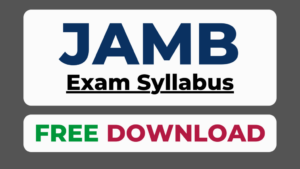The JAMB Syllabus for Biology Pdf Download is designed to cover essential biological concepts and help students prepare for the Joint Admissions and Matriculation Board (JAMB) Unified Tertiary Matriculation Examination (UTME). The syllabus encompasses various aspects of biology, from fundamental processes in living organisms to more complex biological systems.

JAMB Syllabus for Biology Pdf Download
Here’s a detailed breakdown of the topics and subtopics in the JAMB Biology syllabus.
Main Topics in the JAMB Biology Syllabus
1. Concepts of Living Things
This section focuses on the characteristics and classification of living organisms.
- Characteristics of Living Organisms: Nutrition, respiration, excretion, growth, reproduction, movement, and response to stimuli.
- Cell Structure and Functions: Structure of animal and plant cells, functions of cell organelles, and differences between prokaryotic and eukaryotic cells.
- Levels of Organization: Cells, tissues, organs, and systems in plants and animals.
- Classification of Living Organisms: Five kingdoms of living organisms (Monera, Protista, Fungi, Plantae, Animalia), binomial nomenclature, and criteria for classification.
Key Focus:
- Understanding the differences between plant and animal cells.
- Familiarizing yourself with the classification systems and the characteristics of different groups of organisms.
2. Ecology
Ecology is the study of the relationships between organisms and their environment.
- Ecosystems: Components of ecosystems (biotic and abiotic factors), types of ecosystems (terrestrial and aquatic), food chains, food webs, and energy flow.
- Population Ecology: Concepts of population growth, population density, and population regulation.
- Ecological Succession: Primary and secondary succession.
- Conservation of Natural Resources: Importance of conservation, methods of conservation, and the role of humans in conservation.
Key Focus:
- Understanding the flow of energy in ecosystems and the importance of food chains and food webs.
- Learning about the methods of conservation of biodiversity and natural resources.
3. Evolution
Evolution explains how living organisms have changed over time.
- Theories of Evolution: Lamarck’s theory of use and disuse, Darwin’s theory of natural selection.
- Evidence for Evolution: Fossil records, comparative anatomy, and molecular biology.
- Mechanisms of Evolution: Mutation, migration, genetic drift, and natural selection.
Key Focus:
- Understanding the evidence supporting the theory of evolution.
- Familiarizing yourself with the concepts of speciation and natural selection.
4. Genetics and Heredity
Genetics deals with how traits are inherited from one generation to the next.
- Mendelian Genetics: Mendel’s laws of inheritance (law of segregation and independent assortment), monohybrid and dihybrid crosses.
- Chromosomes and Genes: Structure of chromosomes, types of chromosomes (sex chromosomes and autosomes), and linkage.
- Mutation: Types of mutations, causes, and effects of mutations.
- Blood Groups and Inheritance: ABO blood group system and its inheritance patterns.
Key Focus:
- Solving problems on monohybrid and dihybrid crosses.
- Understanding genetic concepts such as dominance, codominance, and incomplete dominance.
5. Reproductive Systems
This section focuses on human and plant reproductive systems and processes.
- Reproduction in Plants: Types of reproduction (sexual and asexual), structure of flowers, pollination, fertilization, and fruit formation.
- Reproduction in Animals: Male and female reproductive systems in humans, gametogenesis (spermatogenesis and oogenesis), menstrual cycle, fertilization, and development.
- Growth and Development: Stages of growth and factors affecting growth.
Key Focus:
- Understanding the structure and function of reproductive organs in both plants and animals.
- Familiarizing yourself with the processes of fertilization and embryonic development.
6. Respiration
- Aerobic and Anaerobic Respiration: Differences between aerobic and anaerobic respiration, glycolysis, Krebs cycle, and electron transport chain.
- Respiratory Organs: Structure and function of the lungs, gills, and stomata in plants.
Key Focus:
- Understanding the biochemical pathways of respiration and the energy yield from each process.
- Learning about the adaptations of respiratory organs in various organisms.
7. Nutrition
Nutrition involves the intake and utilization of nutrients by organisms.
- Modes of Nutrition: Autotrophic (photosynthesis) and heterotrophic (holozoic, saprophytic, parasitic, and symbiotic).
- Plant Nutrition: Photosynthesis (light and dark reactions), mineral nutrition, and deficiency symptoms in plants.
- Animal Nutrition: Digestive system of humans, digestion of carbohydrates, proteins, and fats.
Key Focus:
- Understanding the process of photosynthesis and the factors affecting it.
- Learning about the human digestive system and the role of enzymes in digestion.
8. Excretion
Excretion refers to the process by which waste products are removed from the body.
- Excretory Organs in Animals: Structure and function of kidneys, lungs, skin, and liver in excretion.
- Excretion in Plants: Methods of excretion in plants (transpiration, guttation, and diffusion).
- Osmoregulation: Role of kidneys in osmoregulation and the regulation of body fluids.
Key Focus:
- Understanding the structure and function of the excretory organs.
- Familiarizing yourself with how different organisms excrete waste products.
9. Nervous and Hormonal Coordination
This section explores how organisms coordinate their activities through nervous and hormonal control.
- Nervous System: Structure and function of the central and peripheral nervous systems, neurons, synapses, and reflex actions.
- Endocrine System: Hormonal glands (pituitary, thyroid, pancreas, adrenal), functions of hormones, and feedback mechanisms.
- Sense Organs: Structure and function of the eye, ear, nose, tongue, and skin.
Key Focus:
- Learning the structure and function of the nervous system and the role of hormones in coordinating bodily functions.
- Understanding the mechanisms of feedback regulation in endocrine systems.
10. Transport Systems
Transport involves the movement of materials in plants and animals.
- Transport in Plants: Structure of xylem and phloem, transpiration, translocation, and water absorption.
- Transport in Animals: Structure and function of the circulatory system, blood vessels, heart, and lymphatic system.
Key Focus:
- Understanding the mechanisms of water and nutrient transport in plants.
- Learning the structure and function of the human circulatory system, including the heart and blood vessels.
11. Disease and Immunity
- Types of Diseases: Infectious and non-infectious diseases, causes and symptoms of common diseases.
- Immune System: Body defenses (natural and acquired immunity), vaccines, and antibiotics.
- Public Health: Importance of hygiene, sanitation, and disease prevention.
Key Focus:
- Understanding the types of immunity and how vaccines work.
- Learning about disease prevention and control strategies.
General Tips for Preparing for JAMB Biology
- Study the Key Topics: Focus on understanding biological concepts and processes rather than just memorizing facts.
- Practice Diagrams: Many topics in biology require an understanding of structures (e.g., cell structure, human anatomy). Be sure to practice drawing and labeling diagrams.
- Work on Past Questions: Go through past JAMB Biology questions to familiarize yourself with the exam format and frequently asked topics.
- Use Recommended Textbooks: Ensure you use textbooks that cover the full syllabus and explain concepts in a clear and comprehensive manner.
Recommended Textbooks for JAMB Biology
- “Modern Biology for Senior Secondary Schools” by S.T. Ramalingam.
- “Comprehensive Biology for Senior Secondary Schools” by Charles Adebiyi.
- “Essential Biology for Senior Secondary Schools” by M.C Michael.
Jamb Syllabus FAQS
Is the JAMB syllabus different for UTME and Direct Entry?
The JAMB syllabus is primarily designed for UTME candidates. Direct Entry candidates may not need the syllabus as their admission process is based on their A-level or equivalent qualifications. However, some Direct Entry candidates may still find the syllabus useful if they are required to take certain exams.
How do I know if I’m using the correct JAMB syllabus?
Always download the syllabus from the official JAMB website or trusted educational platforms. Ensure the syllabus is for the correct exam year.
Can I combine the JAMB syllabus with past questions?
Yes, combining the JAMB syllabus with past questions is an excellent strategy. It helps you understand the exam pattern and practice questions based on the syllabus topics.
Can I pass JAMB without using the syllabus?
While it is possible to pass JAMB without the syllabus, using it significantly increases your chances of success. The syllabus ensures you cover all the necessary topics and avoid wasting time on irrelevant material.
Are there recommended textbooks in the JAMB syllabus?
Yes, the JAMB syllabus includes a list of recommended textbooks for each subject. These textbooks are aligned with the syllabus and are useful for in-depth preparation.
How can I use the JAMB syllabus effectively?
- Download the syllabus for your chosen subjects.
- Study the recommended textbooks and materials listed in the syllabus.
- Focus on the objectives and topics outlined for each subject.
- Practice past questions related to the syllabus topics
Does JAMB set questions outside the syllabus?
JAMB has stated that all UTME questions are based on the topics outlined in the syllabus. However, some questions may test candidates' critical thinking and application of knowledge.
How many subjects are in the JAMB syllabus?
The JAMB syllabus covers all the subjects offered in the UTME, including:
- Use of English (compulsory for all candidates).
- Science subjects (e.g., Physics, Chemistry, Biology, Mathematics).
- Arts and Social Science subjects (e.g., Literature, Government, Economics, Commerce).
- Other subjects like Agricultural Science, Geography, and Religious Studies.
Is the JAMB syllabus the same every year?
The JAMB syllabus is periodically reviewed and updated. However, changes are usually minimal. Candidates are advised to always check for the latest version of the syllabus for their exam year.
Where can I download the JAMB syllabus?
The JAMB syllabus is available for free on (jamb-portal). You can also find it on other educational websites or platforms that provide JAMB resources.
Why is the JAMB syllabus important?
- It helps candidates focus on relevant topics.
- It ensures candidates are well-prepared for the exam.
- It reduces the chances of studying irrelevant material.
What is the JAMB syllabus?
The JAMB syllabus is an official document that outlines the topics and subtopics candidates are expected to study for each subject in the Unified Tertiary Matriculation Examination (UTME). It serves as a guide to help candidates prepare effectively for the exam.
Conclusion
The JAMB Biology syllabus covers a wide range of topics, including the structure and function of living organisms, ecology, genetics, and health. To succeed, candidates need to focus on understanding biological concepts, practicing problem-solving, and revising key areas. Regular practice, use of diagrams, and solving past questions will help in achieving high scores in the Biology section of the UTME.
